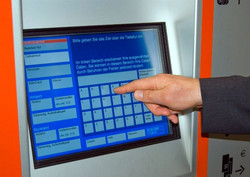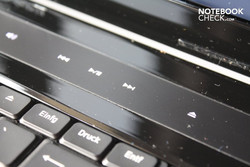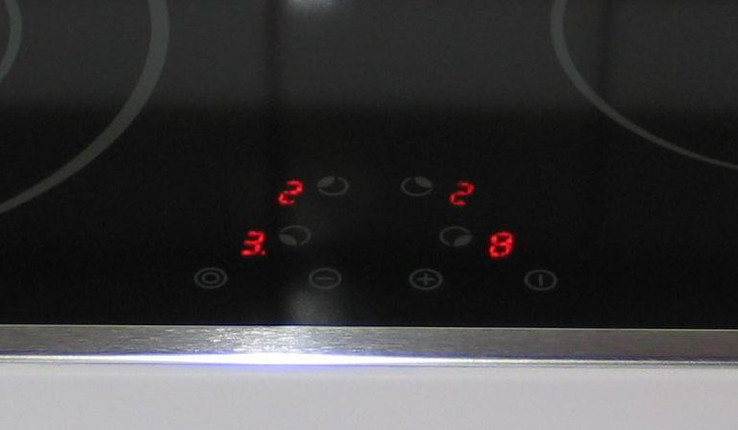Column: Touch me, I wanna be dirty!
by Florian Wimmer 03/02/2010
TouchSensitive
My MP3 player does it, the ATM, my cell phone of course, the ceramic hob, and even the German Rail has also trained their machines quite well: They all respond to a mere touch by the user. No pushing buttons anymore, no extra input fields – everything runs directly over the display. That's amazingly instinctive, isn't it?
Despairing grandmothers stand in German railway stations in front of a red box and search in vain for a button that can be pressed. But – there is none. The rail has integrated touchscreens into its vending machines, which directly respond to the user's touch. Unfortunately, the first generation of these machines was rather busy with showing a mouse cursor that indicated you had just clicked beside the button instead of on it. But of course you had, the system had only detected the touch point incorrectly.
Ticket only for touch
After two or three years of collective agony in German railway stations, the rail decided to set up a new generation of machines that work faster and more reliably. But there still are searching grandmothers in front of the machines.
So why does the German Rail use an operating concept that obviously overtaxes especially older clients and even drove younger people mad with its inaccuracy?
It's because the industry praised the advantages of touchscreens for years. There are a lot less mechanical parts that can get dirty or break – resulting in less maintenance. The operating concept can be changed at anytime, so you can also try out something new, whilst you have to decide which keys you want integrated right from the start in a fixed keyboard. A cheaper software production and the higher protection against vandalism likely also play a role. And people who don't understand the operating method can turn to the service counter found in every railway station – well, almost every railway station – for a small surcharge, of course.
Does the system have any kind of benefit for the client? Admittedly, the new touchscreens used by the German Rail work quite well and meanwhile, if you find out how to make a booking, you can get it done within a short time. But that also worked in prior times with a normal keyboard or at the ticket office (yes, an archaic word).
You don't only encounter displays that invite us to touch them in railway stations. Slowly, touchscreens are even working their way into our homes and, of course, onto our desks. In fact, you could think that the way if the first touchscreens up to their actual circulation has taken quite a long time.
That might be because a unique and really important use for the touchscreen hasn't been found even 36 years after its invention – at least not for the consumer. So, you can draw funny pictures or enlarge your pictures with a finger, and Apple causes a stir with its touch phones and tablet PCs, but working with a touchscreen isn't really more innate or faster in most cases.
Touch me multi!
A lot of devices pass through the hands of a laptop tester. Some have touchscreens, but they are equipped with a touchpad in the very most cases. This technology has been proved and tested over years on end and usually works perfectly as a mouse substitute.
However, the engineers have thought out a new operating concept, over the panic about the iPhone's success as it has convinced many users: multi-touch gestures. The touchpad should therefore recognize that several fingers are placed on it and then even recognize the gestures that these fingers make, so enlarge pictures or scroll pages. Sometimes it works – sometimes it doesn't. In the very most cases, you're at least as fast with the Windows functions.
Touch sense?
One of the most ludicrous developments for the consumer are touch-sensitive keys. Sensor fields that respond to a mere touch. MP3 players, laptops, even ceramic hobs and washing machines are equipped with it in the meantime. The problem: The user doesn't receive any feedback that acknowledges the touch. Where a normal button sends out a palpable reaction, the touch-buttons simply don't give anything back. Additionally, the keys suffer of inaccuracy and sloppy programming.
An example: Dell also follows the trend of touch-sensitive keys and builds in a bar above the keyboard in its Studio 17. A bar that has radiant symbols for volume control, multimedia control and DVD ejecting. But Dell doesn't seem to quite trust its own innovation: All functions can equally be addressed with the F-keys. They respond to every push of a button. Naturally, the touch area has a glossy finish so that fingerprints quickly accumulate there. When you see them in the operating mode and want to remove them, the DVD is suddenly ejected out of the drive, the loudspeakers mute and the next track in the play list is played. But it was just that what you wanted to do with the wiping… or wasn't it?
Apparently the good old principle of form-follows-function doesn't apply very often anymore when touch-technology is built-in. The dials on classic stoves, which were seemingly regarded as ugly, have disappeared. They have made way for a smooth glass plate, over which you have to tell the stove which temperature the hotplate should have to cook your spaghetti by touching cryptic symbols.
And, while we're at it, what do you do when the spaghetti boils over and the hot water flows over the control panel? Well, it's either scalding your fingers or letting it boil over.
Touch the future?!
Naturally, the touch technology is developing and has made enormous progress in the past few years. In the meantime, most devices work quite well, Apple iPhones sales are wonderful and game developers are always inventing new, creative applications for the Nintendo's DS touchscreen. The technology is getting more and more feasible and is even fun, sometimes.
Nevertheless, manufacturers should consider if a blind use of touch-surfaces is really reasonable: Touch-sensitive surfaces for every single computer or household appliance? Perhaps the good old button would occasionally still prove to be a better solution.
It is also always a question for whom the solution is better: It seems some manufacturers don't care if users are left with an impractical control, as long as the devices smoother design sells well. Besides, you'd be taking the risk of missing out on a trend, if you don't use devices with touch-surfaces.
So maybe, the grandmothers don't come out that badly at all. They might be standing in front of a machine full of despair, but at least they still can use the dials on their old stove. Who knows? Maybe the grandmothers will love their touch-stove and we will love our keyboard-less laptop in 30 years.







